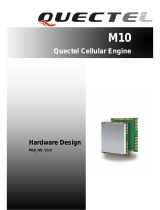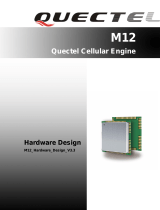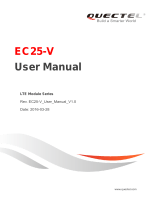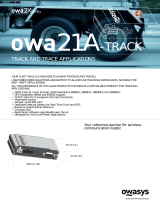Page is loading ...

UC15 Hardware Design
UMTS/HSDPA Module Series
Rev. UC15_Hardware_Design_V1.0
Date: 2013-10-10
www.quectel.com

UMTS/HSDPA Module
UC15 Hardware Design
UC15_Hardware_Design Confidential / Released 1 / 72
Our aim is to provide customers with timely and comprehensive service. For any
assistance, please contact our company headquarter:
Quectel Wireless Solutions Co., Ltd.
Room 501, Building 13, No.99, Tianzhou Road, Shanghai, China, 200233
Tel: +86 21 5108 6236
Mail: [email protected]
Or our local office, for more information, please visit:
http://www.quectel.com/suppo
rt/salesupport.aspx
For technical support, to report documentation errors, please visit:
http://www.quectel.com/support/techsupport.aspx
GENERAL NOTES
QUECTEL OFFERS THIS INFORMATION AS A SERVICE TO ITS CUSTOMERS. THE INFORMATION
PROVIDED IS BASED UPON CUSTOMERS’ REQUIREMENTS. QUECTEL MAKES EVERY EFFORT
TO ENSURE THE QUALITY OF THE INFORMATION IT MAKES AVAILABLE. QUECTEL DOES NOT
MAKE ANY WARRANTY AS TO THE INFORMATION CONTAINED HEREIN, AND DOES NOT ACCEPT
ANY LIABILITY FOR ANY INJURY, LOSS OR DAMAGE OF ANY KIND INCURRED BY USE OF OR
RELIANCE UPON THE INFORMATION. THE INFORMATION SUPPLIED HEREIN IS SUBJECT TO
CHANGE WITHOUT PRIOR NOTICE.
COPYRIGHT
THIS INFORMATION CONTAINED HERE IS PROPRIETARY TECHNICAL INFORMATION OF
QUECTEL CO., LTD. TRANSMITTABLE, REPRODUCTION, DISSEMINATION AND EDITING OF THIS
DOCUMENT AS WELL AS UTILIZATION OF THIS CONTENTS ARE FORBIDDEN WITHOUT
PERMISSION. OFFENDERS WILL BE HELD LIABLE FOR PAYMENT OF DAMAGES. ALL RIGHTS
ARE RESERVED IN THE EVENT OF A PATENT GRANT OR REGISTRATION OF A UTILITY MODEL
OR DESIGN.
Copyright © Quectel Wireless Solutions Co., Ltd. 2013. All rights reserved.

UMTS/HSDPA Module
UC15 Hardware Design
UC15_Hardware_Design Confidential / Released 2 / 72
About the document
History
Revision Date Author Description
1.0 2013-10-10 Felix YIN Initial

UMTS/HSDPA Module
UC15 Hardware Design
UC15_Hardware_Design Confidential / Released 3 / 72
Contents
About the document ................................................................................................................................ 2
Contents .................................................................................................................................................... 3
Table Index ............................................................................................................................................... 5
Figure Inde
x .............................................................................................................................................. 6
1 Introduction ....................................................................................................................................... 7
1.1. Safety
Information ................................................................................................................... 8
2 Product Concept ............................................................................................................................... 9
2.1. General Description ................................................................................................................ 9
2.2. Key
Features ......................................................................................................................... 10
2.3. Functional Diagram ............................................................................................................... 12
2.4. Ev
aluation Board ................................................................................................................... 13
3 Application Interface ....................................................................................................................... 14
3.1. General Description .............................................................................................................. 14
3.2. Pin Ass
ignment ..................................................................................................................... 15
3.3. Pin Descripti
on ...................................................................................................................... 16
3.4. Operating Modes .................................................................................................................. 20
3.5. Power Sav
ing ........................................................................................................................ 22
3.5.1. Sleep Mode.................................................................................................................. 22
3.5.2. W
ake up from Sleep Mode .......................................................................................... 22
3.5.3. Minimum Functionality
Mode ....................................................................................... 22
3.6. Power Suppl
y ........................................................................................................................ 23
3.6.1. Power Suppl
y Pins ....................................................................................................... 23
3.6.2. Decrease V
oltage Drop ................................................................................................ 23
3.6.3. Reference design for power supply ............................................................................. 24
3.6.4. Monitor the Power Suppl
y ............................................................................................ 25
3.6.5. VDD_EXT .................................................................................................................... 25
3.7. T
urn on and off Scenarios ..................................................................................................... 25
3.7.1. T
urn on Module Using the PWRKEY ........................................................................... 25
3.7.2. T
urn off Module ............................................................................................................ 27
3.7.2.1. T
urn off Module Using the PWRKEY Pin .......................................................... 27
3.7.2.2. T
urn off Module Using AT Command ................................................................ 28
3.7.2.3. Automatic S
hutdown ......................................................................................... 28
3.8. Reset the Module .................................................................................................................. 29
3.9. UAR
T Interface ..................................................................................................................... 30
3.9.1. The connection of UAR
T .............................................................................................. 31
3.9.2. UAR
T Application ......................................................................................................... 33
3.10. AUDIO Interface .................................................................................................................... 35
3.10.1. Decrease TDD
noise and other noise .......................................................................... 36
3.10.2. Microphone i
nterfaces configuration ............................................................................ 36
3.10.3. Receiver and speaker interface configuration .............................................................. 37
3.10.4. Earphone interface configuration ................................................................................. 39

UMTS/HSDPA Module
UC15 Hardware Design
UC15_Hardware_Design Confidential / Released 4 / 72
3.11. USIM Card Interface ............................................................................................................. 41
3.11.1. USIM Card
Application ................................................................................................. 41
3.11.2. Design Cons
iderations for USIM Card Holder ............................................................. 43
3.12. USB Interface ........................................................................................................................ 45
3.12.1. Firmware up
grade ........................................................................................................ 46
3.13. ADC Function ........................................................................................................................ 46
3.14. Network S
tatus Indication ...................................................................................................... 47
3.15. Operating S
tatus Indication ................................................................................................... 48
4 Antenna Interface ............................................................................................................................ 50
4.1. Antenna Interface .................................................................................................................. 50
4.1.1. Pin Definition ................................................................................................................ 50
4.1.2. Operating Frequency ................................................................................................... 50
4.1.3. Reference Design ........................................................................................................ 51
4.2. Antenna Inst
allation ............................................................................................................... 51
4.2.1. Antenna Requirement
.................................................................................................. 51
5 Electrical, Reliability
and Radio Characteristics .......................................................................... 52
5.1. Absolute Max
imum Ratings .................................................................................................. 52
5.2. Power Suppl
y Ratings ........................................................................................................... 53
5.3. Operating T
emperature ......................................................................................................... 53
5.4. Current Consumption ............................................................................................................ 54
5.5. RF output power ................................................................................................................... 57
5.6. RF receiv
ing sensitivity ......................................................................................................... 58
5.7. Electros
tatic Discharge ......................................................................................................... 58
6 Mechanical Dimensions.................................................................................................................. 59
6.1. Mechanical Dimensions of the Module.................................................................................. 59
6.2. Footprint of Recommendation ............................................................................................... 62
6.3. T
op View of the Module ......................................................................................................... 63
6.4. Bottom V
iew of the Module ................................................................................................... 63
7 Storage and Manufacturing
............................................................................................................ 64
7.1. Storage.................................................................................................................................. 64
7.2. Manufacturing and W
elding .................................................................................................. 65
8 Appendix A Reference .................................................................................................................... 66
9 Appendix B GPRS Codi
ng Scheme ............................................................................................... 70
10 Appendix C GPRS Multi-
slot Class ................................................................................................ 71
11 Appendix D EDGE Modu
lation and Coding Scheme .................................................................... 72

UMTS/HSDPA Module
UC15 Hardware Design
UC15_Hardware_Design Confidential / Released 5 / 72
Table Index
TABLE 1: UC15 SERIES FREQUENCY BANDS ................................................................................................ 9
TABLE 2: UC15 KEY FEATURES ..................................................................................................................... 10
TABLE 3: IO PARAMETERS DEFINITION ........................................................................................................ 16
TABLE 4: PIN DESCRIPTION ........................................................................................................................... 16
TABLE 5: OVERVIEW OF OPERATING MODES ............................................................................................. 21
TABLE 6: VBAT AND GND PINS ....................................................................................................................... 23
TABLE 7: ELECTRONIC CHARACTERISTICS OF VDD_EXT ........................................................................ 25
TABLE 8: PWRKEY PIN DESCRIPTION .......................................................................................................... 25
TABLE 9: RESET_N PIN DESCRIPTION ......................................................................................................... 29
TABLE 10: PIN DEFINITION OF THE MAIN UART INTERFACE ..................................................................... 31
TABLE 11: LOGIC LEVELS OF DIGITAL I/O .................................................................................................... 31
TABLE 12: PIN DEFINITION OF THE AUDIO INTERFACE ............................................................................. 35
TABLE 13: TYPICAL ELECTRET MICROPHONE CHARACTERISTIC ........................................................... 40
TABLE 14: TYPICAL SPEAKER CHARACTERISTIC ....................................................................................... 40
TABLE 15: PIN DEFINITION OF THE USIM INTERFACE ............................................................................... 41
TABLE 16: PIN DESCRIPTION OF MOLEX USIM CARD HOLDER ................................................................ 43
TABLE 17: PIN DESCRIPTION OF AMPHENOL USIM CARD HOLDER ........................................................ 44
TABLE 18: USB PIN DESCRIPTION ................................................................................................................ 45
TABLE 19: PIN DEFINITION OF THE ADC ...................................................................................................... 47
TABLE 20: CHARACTERISTIC OF THE ADC .................................................................................................. 47
TABLE 21: PIN DEFINITION OF NETWORK INDICATOR ............................................................................... 48
TABLE 22: WORKING STATE OF THE NETWORK INDICATOR .................................................................... 48
TABLE 23: PIN DEFINITION OF STATUS ........................................................................................................ 49
TABLE 24: PIN DEFINITION OF THE RF ANTENNA ....................................................................................... 50
TABLE 25: THE MODULE OPERATING FREQUENCIES ................................................................................ 50
TABLE 26: ANTENNA REQUIREMENTS .......................................................................................................... 51
TABLE 27: ABSOLUTE MAXIMUM RATINGS .................................................................................................. 52
TABLE 28: THE MODULE POWER SUPPLY RATINGS .................................................................................. 53
TABLE 29: OPERATING TEMPERATURE ........................................................................................................ 53
TABLE 30: THE MODULE CURRENT CONSUMPTION .................................................................................. 54
TABLE 31: THE MODULE CONDUCTED RF OUTPUT POWER .................................................................... 57
TABLE 32: THE MODULE CONDUCTED RECEIVING SENSITIVITY ............................................................. 58
TABLE 33: ELECTROSTATICS DISCHARGE CHARACTERISTICS ............................................................... 58
TABLE 34: RELATED DOCUMENTS ................................................................................................................ 66
TABLE 35: TERMS AND ABBREVIATIONS ...................................................................................................... 66
TABLE 36: DESCRIPTION OF DIFFERENT CODING SCHEMES .................................................................. 70
TABLE 37: DESCRIPTION OF DIFFERENT CODING SCHEMES .................................................................. 71
TABLE 38: EDGE MODULATION AND CODING SCHEME ............................................................................. 72

UMTS/HSDPA Module
UC15 Hardware Design
UC15_Hardware_Design Confidential / Released 6 / 72
Figure Index
FIGURE 1: FUNCTIONAL DIAGRAM ............................................................................................................... 13
FIGURE 2: PIN ASSIGNMENT (TOP VIEW) .................................................................................................... 15
FIGURE 3: STAR STRUCTURE OF THE POWER SUPPLY ............................................................................ 24
FIGURE 4: REFERENCE CIRCUIT OF POWER SUPPLY .............................................................................. 24
FIGURE 5: TURN ON THE MODULE USING DRIVING CIRCUIT ................................................................... 26
FIGURE 6: TURN ON THE MODULE USING KEYSTROKE ........................................................................... 26
FIGURE 7: TIMING OF TURNING ON MODULE ............................................................................................. 27
FIGURE 8: TIMING OF TURNING OFF MODULE ........................................................................................... 28
FIGURE 9: REFERENCE CIRCUIT OF RESET_N BY USING DRIVING CIRCUIT ........................................ 30
FIGURE 10: TIMING OF RESETTING MODULE ............................................................................................. 30
FIGURE 11: CONNECTION OF ALL FUNCTIONAL UART PORT ................................................................... 32
FIGURE 12: CONNECTION OF THREE LINES UART PORT ......................................................................... 32
FIGURE 13: CONNECTION OF UART PORT WITH HARDWARE FLOW CONTROL .................................... 33
FIGURE 14: 3.3V LEVEL MATCH CIRCUIT ..................................................................................................... 33
FIGURE 15: 5V LEVEL MATCH CIRCUIT ........................................................................................................ 34
FIGURE 16: RS232 LEVEL MATCH CIRCUIT .................................................................................................. 34
FIGURE 17: MICROPHONE REFERENCE DESIGN FOR MIC1&MIC2 .......................................................... 37
FIGURE 18: REFERENCE DESIGN FOR SPK1 .............................................................................................. 37
FIGURE 19: REFERENCE DESIGN WITH AN AMPLIFIER FOR SPK1 .......................................................... 38
FIGURE 20: REFERENCE DESIGN FOR SPK2 .............................................................................................. 38
FIGURE 21: REFERENCE DESIGN WITH AN AMPLIFIER FOR SPK2 .......................................................... 39
FIGURE 22: REFERENCE DESIGN FOR AN EARPHONE ............................................................................. 39
FIGURE 23: REFERENCE CIRCUIT OF THE 8 PIN USIM CARD ................................................................... 41
FIGURE 24: REFERENCE CIRCUIT OF THE 6 PIN USIM CARD ................................................................... 42
FIGURE 25: MOLEX 91228 USIM CARD HOLDER ......................................................................................... 43
FIGURE 26: AMPHENOL C707 10M006 512 2 USIM CARD HOLDER ........................................................... 44
FIGURE 27: REFERENCE CIRCUIT OF USB APPLICATION ......................................................................... 45
FIGURE 28: CONNECTION OF FIRMWARE UPGRADE ................................................................................ 46
FIGURE 29: REFERENCE CIRCUIT OF THE NETWORK INDICATOR .......................................................... 48
FIGURE 30: REFERENCE CIRCUIT OF THE STATUS ................................................................................... 49
FIGURE 31: REFERENCE CIRCUIT OF ANTENNA INTERFACE ................................................................... 51
FIGURE 32: UC15 TOP AND SIDE DIMENSIONS ........................................................................................... 59
FIGURE 33: UC15 BOTTOM DIMENSIONS (BOTTOM VIEW) ....................................................................... 60
FIGURE 34: BOTTOM PADS DIMENSIONS (BOTTOM VIEW) ....................................................................... 61
FIGURE 35: RECOMMENDED FOOTPRINT (TOP VIEW) .............................................................................. 62
FIGURE 36: TOP VIEW OF THE MODULE ...................................................................................................... 63
FIGURE 37: BOTTOM VIEW OF THE MODULE .............................................................................................. 63
FIGURE 38: LIQUIDS TEMPERATURE ............................................................................................................ 65

UMTS/HSDPA Module
UC15 Hardware Design
UC15_Hardware_Design Confidential / Released 7 / 72
1 Introduction
This document defines the UC15 module and describes its hardware interface which are connected with
user’s application and the air interface.
This document can help users quickly understand module interface specifications, electrical and
mechanical details. Associated with application notes and user guide, users can use UC15 module to
design and set up mobile applications easily.

UMTS/HSDPA Module
UC15 Hardware Design
UC15_Hardware_Design Confidential / Released 8 / 72
1.1. Safety Information
The following safety precautions must be observed during all phases of the operation, such as usage,
service or repair of any cellular terminal or mobile incorporating UC15 module. Manufacturers of the cellular
terminal should send the following safety information to users and operating personnel and to incorporate
these guidelines into all manuals supplied with the product. If not so, Quectel does not take on any liability
for customer failure to comply with these precautions.
Full attention must be given to driving at all times in order to reduce the risk of an
accident. Using a mobie while driving (even with a handsfree kit) cause distraction
and can lead to an accident. You must comply with laws and regulations restricting
the use of wireless devices while driving.
Switch off the cellular terminal or mobile before boarding an aircraft. Make sure it
switched off. The operation of wireless appliances in an aircraft is forbidden to
prevent interference with communication systems. Consult the airline staff about
the use of wireless devices on boarding the aircraft, if your device offers a Airplane
Mode which must be enabled prior to boarding an aircraft.
Switch off your wireless device when in hospitals or clinics or other health care
facilities. These requests are desinged to prevent possible interference with
sentitive medical equipment.
GSM cellular terminals or mobiles operate over radio frequency signal and cellular
network and cannot be guaranteed to connect in all conditions, for example no
mobile fee or an invalid USIM card. While you are in this condition and need
emergent help, please remember using emergency call. In order to make or
receive call, the cellular terminal or mobile must be switched on and in a service
area with adequate cellular signal strength.
Your cellular terminal or mobile contains a transmitter and receiver. When it is ON ,
it receives and transmits radio frequency energy. RF interference can occur if it is
used close to TV set, radio, computer or other electric equipment.
In locations with potencially explosive atmospheres, obey all posted signs to turn
off wireless devices such as your phone or other cellular terminals. Areas with
potencially exposive atmospheres including fuelling areas, below decks on boats,
fuel or chemical transfer or storage facilities, areas where the air contains
chemicals or particles such as grain, dust or metal powders.

UMTS/HSDPA Module
UC15 Hardware Design
UC15_Hardware_Design Confidential / Released 9 / 72
2 Product Concept
2.1. General Description
UC15 is an embedded HSDPA/EDGE engine. Its UMTS-based modem provides data connectivity on
HSDPA, WCDMA, EDGE(DL only), GPRS networks. UC15 offers a maximum data rate of 3.6Mbps on
downlink .UC15 also supports GPRS/EDGE multi-slot class 12. GPRS supports the coding schemes
CS-1, CS-2, CS-3 and CS-4. EDGE supports CS-1 to CS-4 and MCS-1 to MCS-9 coding schemes. UC15
contains two types UC15-A and UC15-E. Customer can choose the dedicated type based on the wireless
network configuration. The following table shows the entire radio band configuration of UC15 series.
Table 1: UC15 Series Frequency Bands
Module
GSM
850
EGSM
900
DCS
1800
PCS
1900
UMTS
850
UMTS
900
UMTS
1900
UMTS
2100
UC15-A z z z z z z
UC15-E z z z z
More details about GPRS/EDGE multi-slot configuration and coding schemes, please refer to Appendix B,
C and D.
With a tiny profile of 29.0mm × 29.0mm × 2.5mm, UC15 can meet almost all requirements for M2M
application such as automotive, metering, tracking system, security solutions, routers, wireless POS,
mobile computing devices, PDA phone and tablet PC, etc.
UC15 is an SMD type module, which can be embedded in customer application through its 108-pin pads
including 68 LCC signal pads and 40 other pads.
UC15 is integrated with internet service protocols like TCP/UDP and PPP. Extended AT commands have
been developed for customer to use these internet service protocols easily.

UMTS/HSDPA Module
UC15 Hardware Design
UC15_Hardware_Design Confidential / Released 10 / 72
2.2. Key Features
The following table describes the detailed features of UC15 module.
Table 2: UC15 Key Features
Feature Details
Power Supply
Supply voltage: 3.3V~4.4V.
Typical supply voltage: 3.8V.
Frequency Bands
GSM Quad-band: GSM850, EGSM900, DCS1800, PCS1900.
UMTS Dual-band: UC15-E 900/2100 MHz, UC15-A 850/1900 MHz.
Transmission Data
HSDPA R5: Max 3.6 Mbps (DL)
W-CDMA R99: Max 384 kbps (DL)/ Max 384 kbps (UL).
EDGE: Max 236.8 kbps (DL)
GPRS: Max 85.6 kbps (DL)/ Max 85.6 kbps (UL).
CSD: 64 kbps.
Transmitting Power
Class 4 (33dBm±2dB) for GSM850 and EGSM900.
Class 1 (30dBm±2dB) for DCS1800 and PCS1900.
Class E2 (27dBm±3dB) for GSM850 and EGSM900 8-PSK.
Class E2 (26dBm+3/-4dB) for DCS1800 and PCS1900 8-PSK.
Class 3 (24dBm+1/-3dB) for UMTS 850/900/1900/2100.
HSDPA and
WCDMA Features
HSDPA data rate is corresponded with 3GPP R5. 3.6 Mbps on
downlink.
WCDMA data rate is corresponded with 3GPP R99/R4. 384 kbps on
downlink and 384kbps on uplink.
Support both QPSK and 16-QAM modulations.
GSM/GPRS/EDGE
Data Features
GPRS:
Support GPRS multi-slot class 12 (10 by default).
Coding scheme: CS-1, CS-2, CS-3 and CS-4.
Maximum of four Rx time slots per frame.
EDGE:
Support EDGE multi-slot class 12 (12 by default).
Support GMSK and 8-PSK for different MCS (Modulation and Coding
scheme).
Downlink coding schemes: CS 1-4 and MCS 1-9.
CSD:
CSD transmission rates: 64 kbps non-transparent.
Support Unstructured Supplementary Services Data (USSD).
Internet Protocol Features
Support TCP/PPP/UDP protocols.
Support the protocols PAP (Password Authentication Protocol) and
CHAP (Challenge Handshake Authentication Protocol) usually used
for PPP connections.

UMTS/HSDPA Module
UC15 Hardware Design
UC15_Hardware_Design Confidential / Released 11 / 72
SMS
Text and PDU mode.
Point to point MO and MT.
SMS cell broadcast.
SMS storage: ME by default.
USIM Interface
Support USIM card: 1.8V, 3V.
Support USIM and SIM.
Audio Features
Support two analogy input channels and two analogy output channels.
GSM: HR/FR/EFR/AMR.
WCDMA: AMR.
Echo cancellation and noise suppression.
UART Interface
Seven lines on UART interface.
Support RTS and CTS hardware flow control.
Baud rate can reach up to 460800bps, 115200 bps by default.
Used for AT command, data transmission .
USB Interface
Compliant with USB 2.0 specification (slave only), the data transfer
rate can reach up to 480 Mbps.
Used for AT command communication, data transmission, software
debug and firmware upgrade.
USB Driver: Support Windows XP, Windows Vista, Windows7,
Windows 8, Windows CE5.0*/6.0*, Linux 2.6/3.0, Android 2.3/4.0.
AT Commands
Compliant with 3GPP TS 27.007, 27.005 and Quectel enhanced AT
commands.
Network Indication Indicate network connectivity status.
Antenna Interface Connected via 50 Ohm antenna pad.
Physical Characteristics
Size: 29.0±0.15 × 29.0±0.15 × 2.5±0.2 mm.
Weight: approx. 6 g.
Temperature Range
Normal operation: -40°C ~ +80°C.
Restricted operation: -45°C ~ -40°C and +80°C ~ +85°C 1).
Storage temperature: -40°C ~ +90°C.
Firmware Upgrade USB interface(by default) .
RoHS All hardware components are fully compliant with EU RoHS directive.
1.
1)
means
when the module works within this temperature range, RF performance might degrade. For
example, the frequency error or the phase error would increase.
NOTES

UMTS/HSDPA Module
UC15 Hardware Design
UC15_Hardware_Design Confidential / Released 12 / 72
2.3. Functional Diagram
The following figure shows a block diagram of UC15 and illustrates the major functional parts.
z Power management
z Baseband
z DDR+NAND flash
z Radio frequency
z Peripheral interface
--UART interface
--USIM card interface
--USB interface
--AUDIO interface
--ADC interface
--Status indication
--Control interface

UMTS/HSDPA Module
UC15 Hardware Design
UC15_Hardware_Design Confidential / Released 13 / 72
Figure 1: Functional Diagram
2.4. Evaluation Board
In order to help user to develop applications with UC15, Quectel supplies an evaluation board (EVB),
RS-232 to USB cable, USB data cable, power adapter, earphone, antenna and other peripherals to
control or test the module. For details, please refer to document [2].

UMTS/HSDPA Module
UC15 Hardware Design
UC15_Hardware_Design Confidential / Released 14 / 72
3 Application Interface
3.1. General Description
UC15 is equipped with a 68-pin 1.3mm pitch SMT pads plus 40-pin ground pads and reserved pads that
connect to customer’s cellular application platform. Sub-interfaces included in these pads are described in
detail in the following chapters:
z Power supply
z UART interface
z Audio interface
z USIM interface
z USB interface
z ADC interface
z Status indication

UMTS/HSDPA Module
UC15 Hardware Design
UC15_Hardware_Design Confidential / Released 15 / 72
3.2. Pin Assignment
The following figure shows the pin assignment of the UC15 module.
32
17
18
19
20
21
22
23
24
25
26
27
28
29
30
31
64
63
62
61
60
59
58
57
56
55
54
53
52
51
50
49
RESET_N
PWRKEY
AGND
SPK2P
SPK1N
SPK1P
MIC1P
MIC1N
MIC2P
MIC2N
RESERVED
RESERVED
RESERVED
RESERVED
RESERVED
RESERVED
USB_VBUS
USB_DM
USB_DP
RXD
TXD
DTR
RTS
CTS
DCD
RI
STATUS
VBAT_BB
VBAT_BB
VBAT_RF
VBAT_RF
GND
Figure 2: Pin Assignment (Top view)
Keep all reserved pins and unused pins unconnected.
NOTE

UMTS/HSDPA Module
UC15 Hardware Design
UC15_Hardware_Design Confidential / Released 16 / 72
3.3. Pin Description
The following tables show the UC15’s pin definition.
Table 3: IO Parameters Definition
Type Description
IO Bidirectional input / output
DI Digital input
DO Digital output
PI Power input
PO Power output
AI Analog input
AO Analog output
Table 4: Pin Description
Power Supply
Pin Name Pin No. I/O Description DC Characteristics Comment
VBAT_BB 52,53 PI
Power supply for
module baseband
part.
Vmax = 4.4V
Vmin = 3.3V
Vnorm = 3.8V
It must be able to
provide sufficient
current up to 0.8A.
VBAT_RF 50,51 PI
Power supply for
module RF part.
Vmax = 4.4V
Vmin = 3.3V
Vnorm = 3.8V
It must be able to
provide sufficient
current in a transmitting
burst which typically
rises to 2.0A.
VDD_EXT 7 PO
Provide 2.6V for
external circuit.
Vnorm = 2.6V
I
O
max = 100mA
If unused, keep this pin
open.
Recommend to add a
2.2~4.7uF bypass
capacitor when using
this pin for power
supply.

UMTS/HSDPA Module
UC15 Hardware Design
UC15_Hardware_Design Confidential / Released 17 / 72
GND
42,44~49
65,67~68
71~73,81
~108
Ground.
Turn On/Off
Pin Name Pin No. I/O Description DC Characteristics Comment
PWRKEY 18 DI
Turn on/off the
module.
R
PU
≈ 200kΩ
V
IH
max = 2.1V
V
IH
min = 1.6V
V
IL
max = 0.3V
Pull-up to 1.8 V
internally.
RESET_N 17 DI RESET the module.
V
IH
max = 2.1V
V
IH
min = 1.6V
V
IL
max = 0.3V
Pull-up to 1.8 V
internally.
Active low.
Status indication
Pin Name Pin No. I/O Description DC Characteristics Comment
STATUS 54 DO
Indicate the module
operating status.
V
OH
max = 2.6V
V
OH
min = 2.15V
V
OL
max = 0.45V
2.6V power domain.
NETLIGHT 6 DO
Indicate the module
network activity
status.
V
OH
max = 2.6V
V
OH
min = 2.15V
V
OL
max = 0.45V
2.6V power domain.
USB interface
Pin Name Pin No. I/O Description DC Characteristics Comment
USB_VBUS 64 PI USB detection.
Vmax = 5.25V
Vmin = 4.75V
Vnorm = 5.0V
USB_DP 62 IO
USB differential data
bus.
Compliant with USB
2.0 standard
specification.
Require differential
impedance of 90Ω.
USB_DM 63 IO
USB differential data
bus.
Compliant with USB
2.0 standard
specification.
Require differential
impedance of 90Ω.
USIM interface
Pin Name Pin No. I/O Description DC Characteristics Comment

UMTS/HSDPA Module
UC15 Hardware Design
UC15_Hardware_Design Confidential / Released 18 / 72
USIM_GND 8
Specified ground for
USIM card.
USIM_VDD 12 PO
Power supply for
USIM card.
For 1.8V USIM:
Vmax = 1.95V
Vmin = 1.65V
For 3V USIM:
Vmax = 3.3V
Vmin = 2.7V
I
O
max = 150mA
Either 1.8V or 3V is
supported by the
module automatically.
USIM_DATA 13 IO
Data signal of USIM
card.
For 1.8V USIM:
V
IL
max = 0.63V
V
IH
min = 1.17V
V
IH
max = 2.1V
V
OL
max = 0.45V
V
OH
min = 1.35V
For 3V USIM:
V
IL
max = 1.05V
V
IH
min = 1.95V
V
IH
max=
USIM_VDD+0.3
V
OL
max = 0.45V
V
OH
min=
0.7*USIM_VDD
Pull-up to USIM_VDD
with 10k resistor
internally.
USIM_CLK 14 DO
Clock signal of USIM
card.
For 1.8V USIM:
V
OL
max = 0.45V
V
OH
min = 1.35V
For 3V USIM:
V
OL
max = 0.45V
V
OH
min=
0.7*USIM_VDD
USIM_RST 15 DO
Reset signal of
USIM card.
For 1.8V USIM:
V
OL
max = 0.45V
V
OH
min = 1.35V
For 3V USIM:
V
OL
max = 0.45V
V
OH
min=
0.8*USIM_VDD

UMTS/HSDPA Module
UC15 Hardware Design
UC15_Hardware_Design Confidential / Released 19 / 72
USIM_
PRESENCE
11 DI
USIM card input
detection.
V
IL
min = -0.3V
V
IL
max = 0.91V
V
IH
min = 1.69V
V
IH
max = 2.9V
2.6V power domain.
ADC interface
Pin Name Pin No. I/O Description DC Characteristics Comment
ADC0 41 AI
General purpose
analog to digital
converter.
Voltage range:
0V to 2.1V
ADC1 40 AI
General purpose
analog to digital
converter.
Voltage range:
0V to 2.1V
UART interface
Pin Name Pin No. I/O Description DC Characteristics Comment
RI 55 DO Ring indicator.
V
OL
max = 0.45V
V
OH
min = 2.15V
2.6V power domain.
DCD 56 DO
Data carrier
detection.
V
OL
max = 0.45V
V
OH
min = 2.15V
2.6V power domain.
CTS 57 DO Clear to send.
V
OL
max = 0.45V
V
OH
min = 2.15V
2.6V power domain.
RTS 58 DI Request to send.
V
IL
min = -0.3V
V
IL
max = 0.91V
V
IH
min = 1.69V
V
IH
max = 2.9V
2.6V power domain.
DTR 59 DI Data terminal ready.
V
IL
min = -0.3V
V
IL
max = 0.91V
V
IH
min = 1.69V
V
IH
max = 2.9V
2.6V power domain.
TXD 60 DO Transmit data.
V
OL
max = 0.45V
V
OH
min = 2.15V
2.6V power domain.
RXD 61 DI Receive data.
V
IL
min = -0.3V
V
IL
max = 0.91V
V
IH
min = 1.69V
V
IH
max = 2.9V
2.6V power domain.
RF interface
Pin Name Pin No. I/O Description DC Characteristics Comment
RF_ANT 43 IO RF antenna pad 50Ω impedance
/









